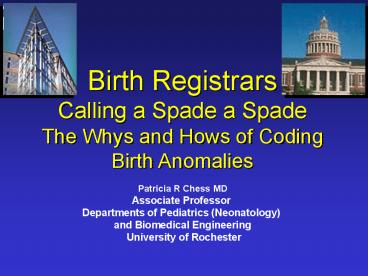Patricia R Chess MD - PowerPoint PPT Presentation
1 / 28
Title:
Patricia R Chess MD
Description:
Down Syndrome ( /- karyotype) Other Chromosomal Disorder ( /- karyotype) Hypospadias ... Down Syndrome. High diagnostic sensitivity of prenatal USG and triple screen ... – PowerPoint PPT presentation
Number of Views:131
Avg rating:3.0/5.0
Title: Patricia R Chess MD
1
Birth Registrars Calling a Spade a Spade The Whys
and Hows of Coding Birth Anomalies
Patricia R Chess MD Associate Professor
Departments of Pediatrics (Neonatology) and
Biomedical Engineering University of Rochester
2
Overview
- Why code?
- What to code
- Description of coded anomalies, how they are
diagnosed - Review of diagnostic screens used for coding
- Incidence of coded anomalies
- Using coded data for research
3
The ultimate goal is to optimize maternal-infant
health and well-being
4
Why Code Anomalies
- Determine incidence
- Is incidence changing, and if so, why
- Establish patterns (demographics/ epidemiology)
- Identify possible environmental, ethnic (genetic)
or cultural links - Assess necessary resources
- Project future needs
5
Which Anomalies to Code
- Anencephaly
- Meningomyelocele (aka spina bifida)
- Cyanotic congenital heart disease
- Congenital diaphragmatic hernia
- Gastroschisis
- Omphalocele
- Limb reduction defects
- Cleft lip /- cleft palate
- Down Syndrome (/- karyotype)
- Other Chromosomal Disorder (/- karyotype)
- Hypospadias
6
Anencephaly
- Lacking the cortex (thinking, motor part of the
brain) brainstem present (controls reflex
neurologic functions such as breathing) - Diagnosed prenatally if USG performed
7
Neural Tube DefectsSpina Bifida
- Most detected prenatally, otherwise at birth
- Decreased incidence with folic acid
supplementation
8
Cyanotic Congenital Heart Disease blue baby,
diagnosed by fetal or postnatal cardiac ECHO,
usually needs prostaglandins to survive
- Tetralogy of Fallot with significant pulmonic
stenosis - Total Anomalous Pulmonary Venous Return
- Transposition of the Great Vessels
- Tricuspid Atresia
- Truncus
- Hypoplastic Left heart
9
Congenital Diaphragmatic Hernia
- Usually detected prenatally, confirmed by chest
x-ray
Normal
Intestines herniating into chest cavity though
hole in diaphragm
10
Gastroschisis
Isolated herniation of intestines through defect
in abdominal wall, usually diagnosed prenatally
by USG
11
Omphalocele
Intestines within umbilical cord, frequently has
other anomalies (CHD, chromosomal anomalies),
frequently diagnosed prenatally by USG
12
Limb Reduction Defectfrequently diagnosed
prenatally by USG
Thalidomide Amniotic Banding Dwarfism Chicken
Pox (not coded) (not coded) TAR
Syndrome shortened limbs, fingers/toes
present
13
Cleft lip /- Cleft palate
Usually diagnosed at birth
14
Cleft Palate Alone
Usually diagnosed at birth
15
Down Syndrome
- High diagnostic sensitivity of prenatal USG and
triple screen - Confirmed by chromosomes from amnio or post
delivery
16
Other Chromosomal AnomaliesTrisomy 13, 18 most
common
- Could be suspected on USG, diagnosed by
chromosomes from CVS, amniocentesis or after
birth (exam leads to clinical diagnosis,
chromosomes confirm)
17
Trisomy 13 Midline defects common
Cleft lip, small for gestational age
Cutis aplasia- skin defect on scalp
Syndactyly- fingers, toes not normally separated
Extra chromosome 13
18
Trisomy 18
Small for gestational age
Overriding fingers
Rocker bottom feet
Extra chromosome 18
19
Hypospadias
End of urethra does not end at tip of
penis. Detected on physical exam, not prenatally
20
What is a level II Ultrasound?
- Level I- Is there a baby and is there a
heartbeat? - eg quick scan in the ED
- Level II- Are there all the necessary organs and
do they look normal? - eg 16 week anatomic scan in the OBs office
- Level III- If the organs dont look normal, what
exactly is wrong with them? - eg referral to GCHaS for fetal ECHO by Pediatric
Cardiologist
21
Other Screening Tests Coded
- MSAFP/ triple screen Maternal blood work with
norms established - MSAFP maternal serum ?- feto protein
- Low in trisomy 21 (T21), aneuploidy
- Elevated in neural tube defects, ventral wall
defects, tumors, dermatologic disorders,
congenital nephrosis - hCG human chorionic gonadotropin
- Elevated in T21
- uE 3 unconjugated estriol
- Low in T21
- IH-A inhibin A (quad screen)
- Elevated in T21
- Chorionic Villous Sample (CVS) chromosomes
determined on cells from chorionic tissue early
in pregnancy - Amniocentesis chromosomes determined from cells
in amniotic fluid in second/ third trimester
22
Incidence of Coded Anomalies
- Anencephaly 1/68,000 births
- Meningomyelocele (aka spina bifida)
- 1996 10.5/ 10,000 livebirths
- 2003 5/10,000
- Congenital heart disease 8/1000, 15 cyanotic
- Congenital diaphragmatic hernia 1/2200
- Gastroschisis
- 1997 2.9/1000
- 2001 5/1000
- Omphalocele 1/4000
23
Incidence (continued)
- Limb reduction defects 659/1.2 million
- Cleft lip cleft palate 1/1000
- Cleft palate alone 1500
- Down Syndrome 1/800
- Other Chromosomal Disorder
- Trisomy 13 1/5000
- Trisomy 18 1/3000
- Hypospadias
- 1970s 1/250 boys
- 1990s 1/125 boys
24
Research Using Database Data
- Uses de-identified data
- Each research project reviewed by hospital-based
institutional review board - Results often provide information that can help
identify trends and improve health care for
future patients - Critical to have accurate data
25
Example of using database to determine population
statistics
T Stevens et al
26
- If there is a significant birth defect present
that is not currently coded, hospital required to
report to NYS Congenital Malformations Registry
518-402-7990
27
Accurate coding of birth registry data provides
information which can help establish the need for
services and can be used to identify potential
causal links to suboptimal outcomes and suggest
future interventions to optimize health in
newborns.
28
(No Transcript)
















![NOTE: To appreciate this presentation [and insure that it is not a mess], you need Microsoft fonts: PowerPoint PPT Presentation](https://s3.amazonaws.com/images.powershow.com/4691906.th0.jpg?_=20200514087)







![NOTE: To appreciate this presentation [and insure that it is not a mess], you need Microsoft fonts: PowerPoint PPT Presentation](https://s3.amazonaws.com/images.powershow.com/5087845.th0.jpg?_=20200513099)





![NOTE: To appreciate this presentation [and ensure that it is not a mess], you need Microsoft fonts: PowerPoint PPT Presentation](https://s3.amazonaws.com/images.powershow.com/6427398.th0.jpg?_=20200728051)
